Identifying the Dished Profile
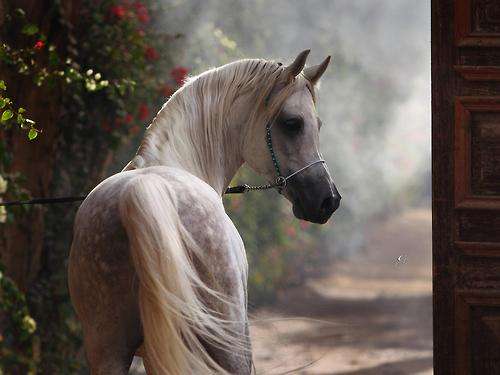
The dished profile, a hallmark feature of Arabian horses, is characterized by a concave facial
Arabian horses, is characterized by a concave facial contour between the eyes and nostrils. This distinctive trait varies in prominence among Arabians, ranging from subtle to pronounced. While traditionally valued, extreme dishing can be controversial:
- Moderate dishing is considered desirable and doesn’t affect breathing1
- Extreme dishing may be associated with modern breeding practices2
- Some Arabians have minimal dishing, especially those from certain bloodlines3
- The appearance of a dish can be enhanced when the horse flares its nostrils1
- Geometric morphometric studies have identified three distinct face shape subgroups within Arabians, including both dished and straight profiles4
It’s important to note that not all Arabians exhibit pronounced dishing, and the trait’s prominence can vary significantly within the breed23.
Recognizing the Floating Trot
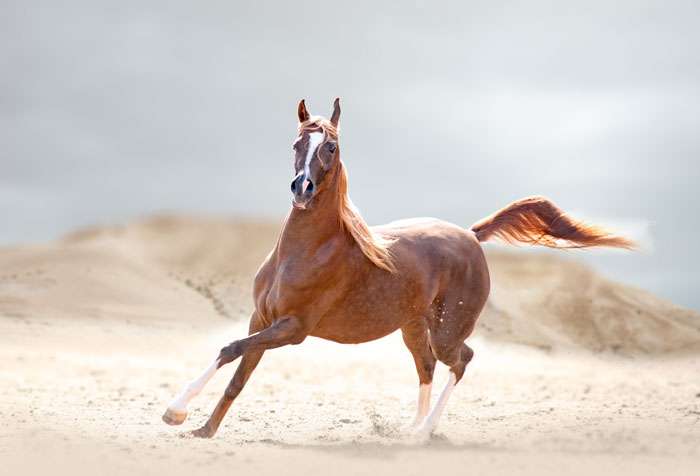
The floating trot is a distinctive gait that sets Arabian horses apart from other breeds. This elegant movement is characterized by:
- A light, springy step with high knee and hock action12
- The appearance of the horse gliding or floating above the ground12
- Exceptional suspension, with all four feet leaving the ground momentarily3
- An energetic, proud, and graceful attitude during movement13
This unique trot not only showcases the Arabian’s natural athleticism but also contributes to their smooth ride. The floating trot is a result of the breed’s compact body structure, strong hindquarters, and horizontal pelvic bone position, which allow for efficient energy transfer and elevated movement23. This gait is particularly prized in show rings and dressage competitions, where it exemplifies the Arabian’s innate beauty and grace in motion.
Spotting High Tail Carriage

Arabian horses are renowned for their distinctive high tail carriage, a trait that sets them apart from other breeds. This characteristic is not just aesthetic but also functional:
- The tail is typically carried in an elevated, arched position, especially when the horse is excited or in motion12
- High tail carriage is a natural feature, not artificially created or maintained
- It’s considered a more reliable indicator of Arabian blood than head shape in mixed breeds3
- The tail’s position contributes to the overall impression of pride and elegance associated with Arabians
- During movement, the high tail accentuates the horse’s floating gait and adds to its graceful appearance
While the degree of tail elevation can vary among individuals, a consistently high tail carriage is a hallmark of the Arabian breed and a key feature to look for when identifying these horses.
Arabian Horse Coat Colors
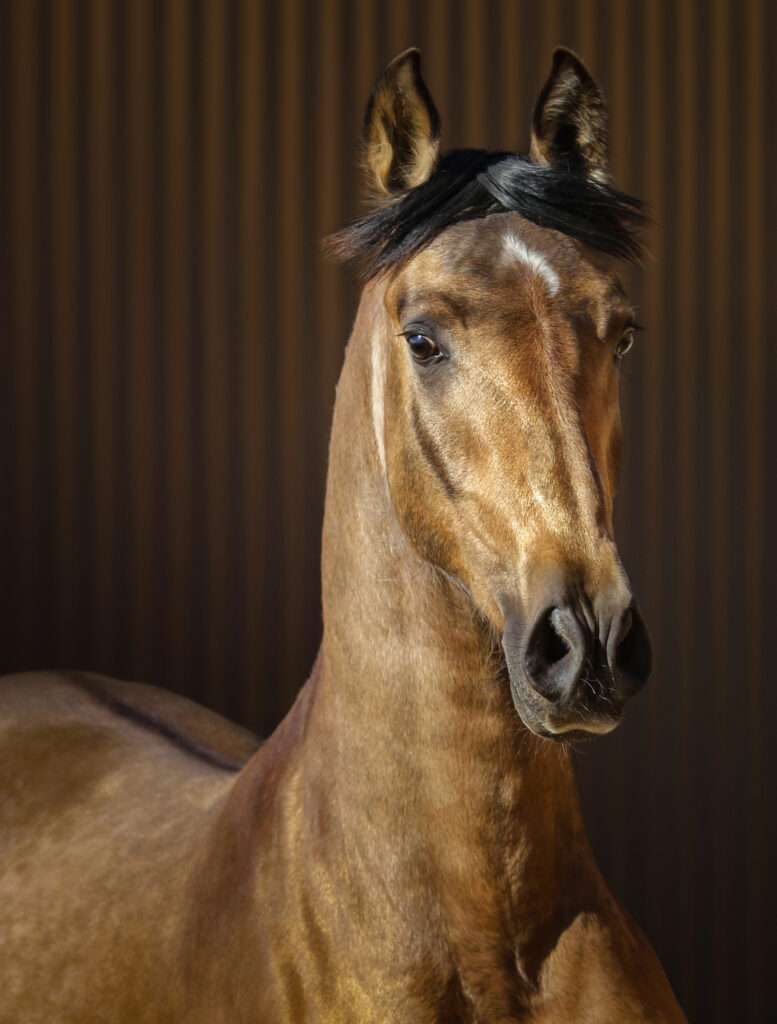
Arabian horses are renowned for their distinctive coat colors, which are limited to a specific range due to their genetic makeup. The Arabian Horse Association officially recognizes five coat colors: bay, gray, chestnut, black, and roan12. Here’s a breakdown of these colors and their prevalence:
- Bay: The most common color, accounting for approximately one-third of all Arabians3
- Gray: The second most prevalent, making up slightly less than one-third of the population 3
- Chestnut: Comprises about 15% of Arabians3
- Black: Relatively rare, often grouped with brown and together making up around 20% of the breed3
- Roan (often called rabicano): The rarest color in Arabians3
It’s important to note that Arabians do not carry dilution genes, so colors like dun, cremello, palomino, or buckskin are not found in purebred Arabians14. White markings on the face and legs are permissible, as is the presence of the sabino gene, which can create a “sabino-like” pattern5. The coat colors of Arabians often have a distinctive metallic sheen, which can make light chestnuts appear golden and grays look almost white as they age14.
Black Arabian Horses
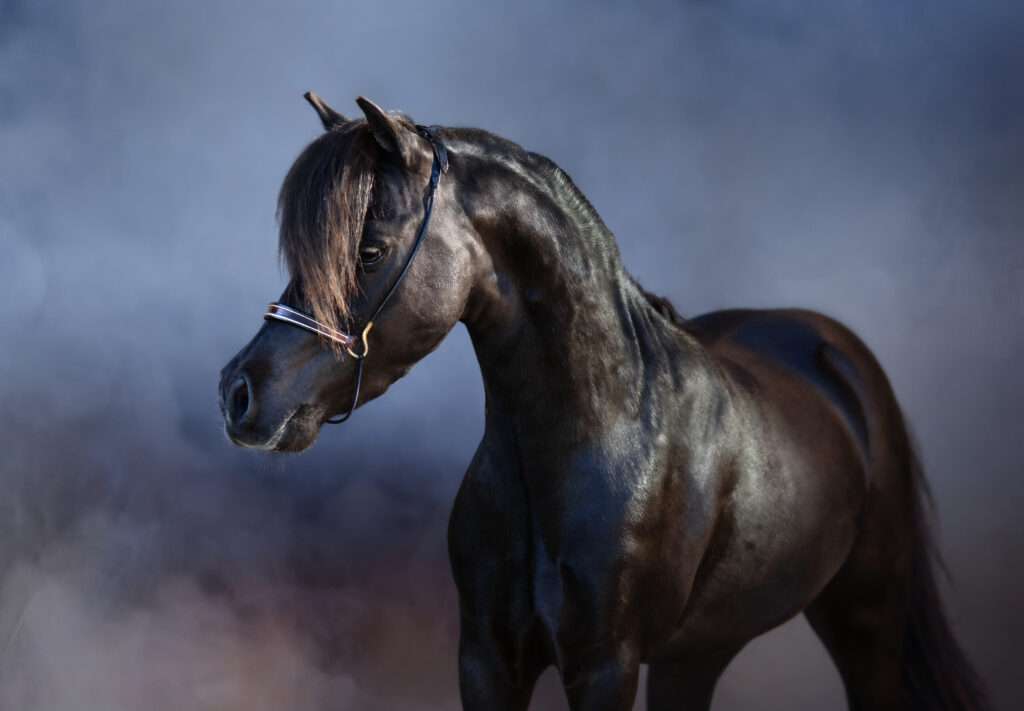
Black Arabian horses are a rare and striking variation within the breed. While black is recognized as one of the coat colors for purebred Arabians, it is less common than bay, gray, or chestnut12. The rarity of black Arabians adds to their allure and value among enthusiasts. Key points about black Arabian horses include:
- True black Arabians have black skin and coat without any brown hairs
- They often appear to have a bluish sheen to their coat in sunlight
- Black is a recessive gene in Arabians, making it less frequent
- Some black foals may gray out as they mature
- Black Arabians retain all the breed’s characteristic features like the dished face, arched neck, and high tail carriage13
Despite their color, black Arabians possess the same athletic abilities, intelligence, and gentle temperament that the breed is known for4. Their striking appearance makes them particularly popular in shows and as pleasure horses.
White Arabian Horses
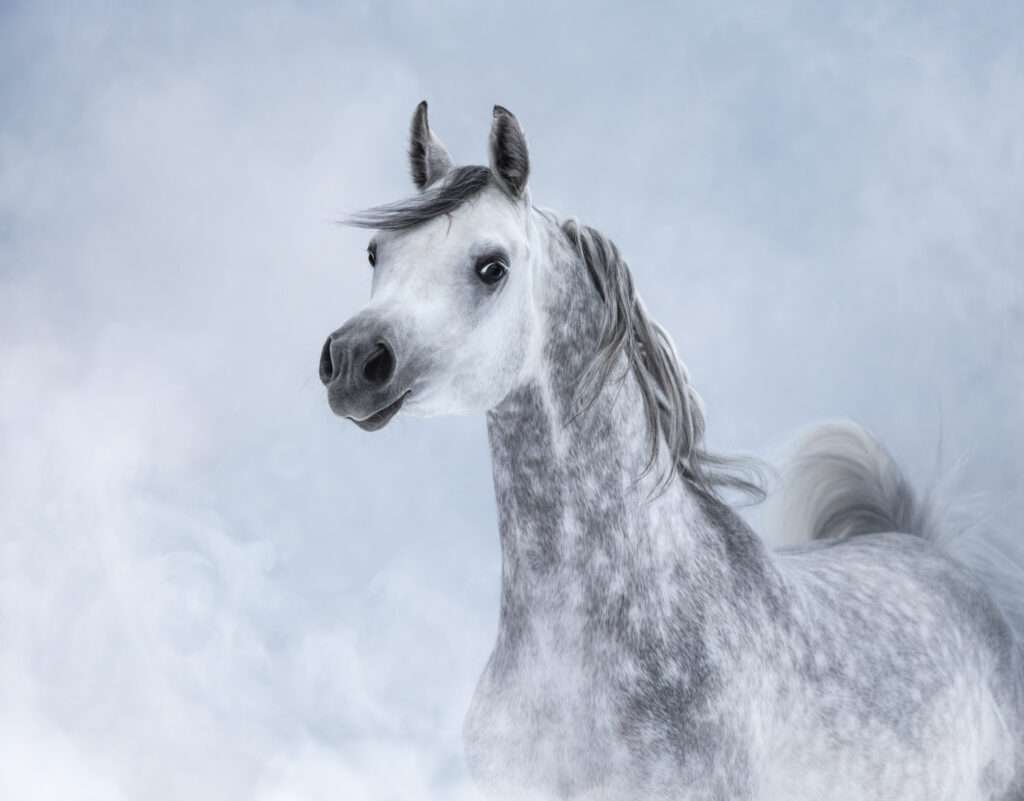
White Arabian horses, while striking in appearance, are not actually a distinct color within the breed. What is often referred to as “white” in Arabians is typically a variation of the gray coat color. True white horses are extremely rare in Arabians due to genetic factors1. Key points about “white” Arabian horses:
- Most “white” Arabians are born dark and gradually lighten to a white-like appearance as they age
- This process is called “graying out” and is controlled by a dominant gene
- Some Arabians may appear nearly white by age 6-8, while others may retain some darker hairs
- Unlike true white horses, gray Arabians have dark skin under their coat
- Occasionally, Arabians may carry the dominant white gene, resulting in a white coat from birth, but this is very uncommon23
Gray Arabians that appear white retain all the breed’s characteristic features, including the dished face, arched neck, and high tail carriage. Their light coloration often accentuates these traits, making them particularly popular in shows and as pleasure horses4.
iRide Egypt Arabian Adventures
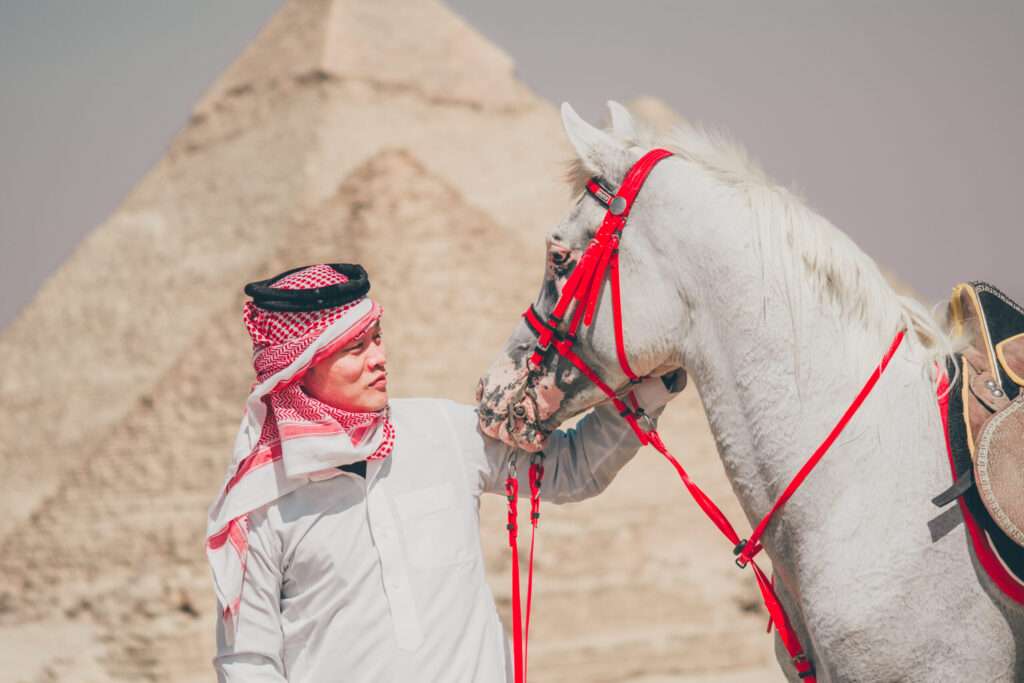
For those eager to experience the thrill of riding Arabian horses in Egypt, iRide Egypt offers a unique opportunity to mount these majestic animals, including rare black and striking white Arabians. The company provides carefully curated riding experiences that cater to all skill levels, from beginners to experienced equestrians1.iRide Egypt’s offerings include:
- Rides near the iconic Pyramids of Giza
- Desert trail adventures
- Scenic waterfront routes
- Professional photoshoots to capture your experience
- Rides on both black and white Arabian horses, showcasing the breed’s color diversity
Guests praise the company for their well-cared-for horses, knowledgeable guides, and ability to accommodate different riding abilities1. To explore available plans and book your Arabian horse riding adventure in Egypt, visit iRide Egypt’s website for more information on their packages and scheduling options.
Golden Arabian Myth
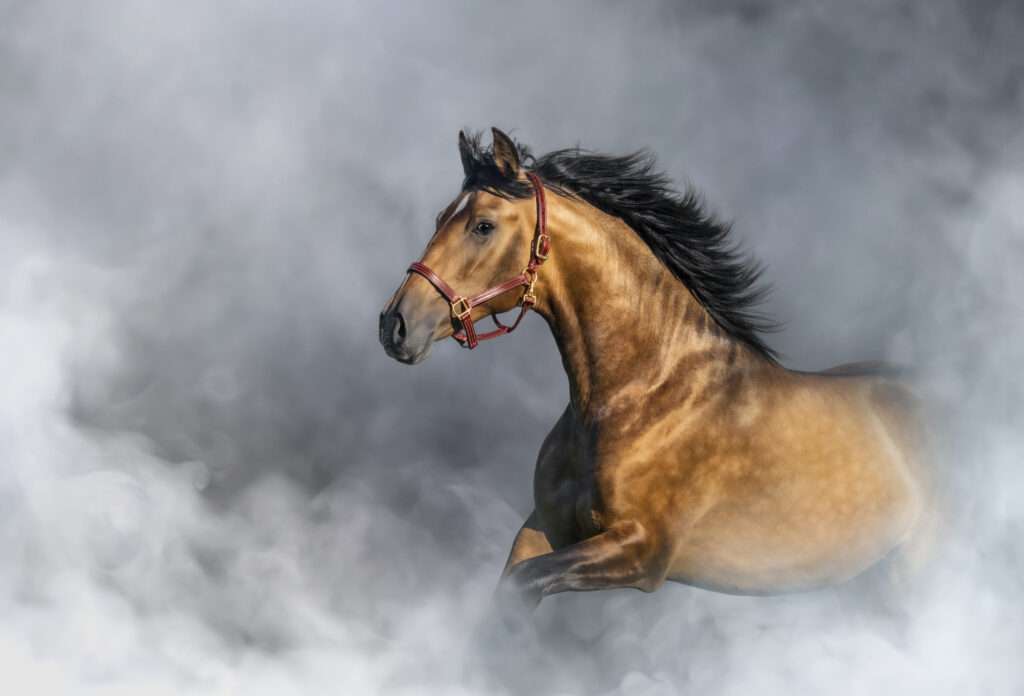
While the term “golden Arabian horse” is sometimes used colloquially, it’s important to note that there is no official “golden” color in purebred Arabian horses. What is often referred to as “golden” is typically either a light chestnut or a buckskin-like coat color. However, true buckskin coloration does not exist in purebred Arabians as they lack the dilution genes necessary for this color1. Horses that appear golden in Arabians are usually:
- Light chestnuts with flaxen manes and tails, which can give a golden appearance
- Palomino-like coloration, which is actually a very light chestnut
- Bay horses with a particularly golden hue to their coat
It’s worth noting that the metallic sheen often associated with a “golden” appearance is more characteristic of breeds like the Akhal-Teke, known for their distinctively shiny coats2. While Arabians can have a glossy coat, they do not possess the same degree of metallic shine. The Arabian Horse Association recognizes coat colors of bay, gray, chestnut, black, and roan for purebred Arabians3.
Arabian Horse Marketplace

Arabian horses are highly sought-after for their beauty, intelligence, and versatility, making them popular in the equestrian market. When looking for Arabian horses for sale, potential buyers can explore various options:
- Online marketplaces like Arabian Horse Exchange and DreamHorse.com offer extensive listings of Arabians for sale12
- Prices can range widely, from around $3,000 to over $100,000, depending on factors like pedigree, training, and show record3
- Reputable breeders and specialized Arabian horse farms often have horses available for purchase4
- Buyers can find Arabians of different ages, from yearlings to mature horses, and various coat colors including bay, chestnut, and the rarer black25
- Some sellers offer part-bred Arabians, which can be more affordable while still retaining many desirable Arabian traits5
When considering an Arabian horse for purchase, it’s important to evaluate the horse’s temperament, conformation, and suitability for your intended use, whether it be for showing, endurance riding, or pleasure riding64.
American Arabian Horse Association
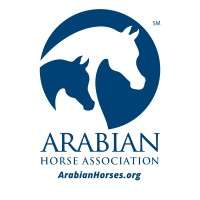
The Arabian Horse Association (AHA) is the primary registry and membership organization for Arabian horses in the United States. Formed in 2003 through the merger of the International Arabian Horse Association (IAHA) and the Arabian Horse Registry of America (AHRA), the AHA plays a crucial role in promoting and preserving the Arabian horse breed12. Key aspects of the AHA include:
- Maintains the registry for purebred Arabian, Half-Arabian, and Anglo-Arabian horses in the United States1
- Organizes national championship shows, including U.S. Nationals, Youth Nationals, and Sport Horse Nationals13
- Offers youth programs and scholarships through the Arabian Horse Youth Association (AHYA)1
- Provides educational resources and promotes Arabian horses through various outreach initiatives4
- Collaborates with the United States Equestrian Federation to sanction horse shows and license judges for Arabian horses1
As of 2019, the AHA had approximately 18,000 members and has registered over 665,000 purebred Arabians since its inception3. The organization continues to play a vital role in maintaining breed standards and promoting Arabian horses in various equestrian disciplines.
Arabian Show Circuit
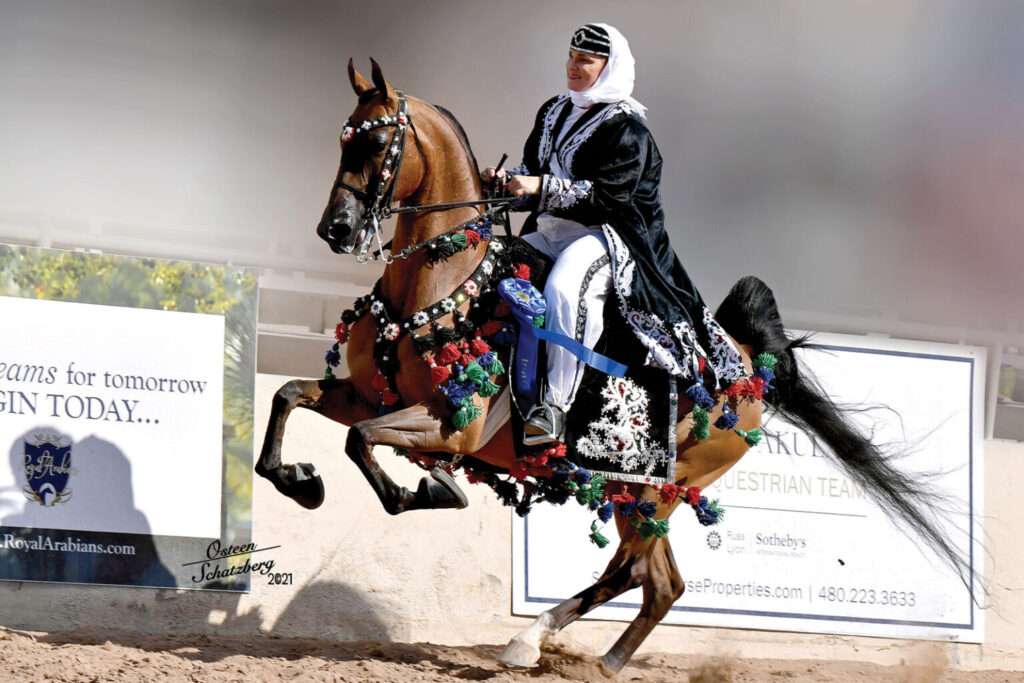
Arabian horse shows are prestigious events that showcase the beauty, athleticism, and versatility of the breed. These competitions range from local to international levels, attracting enthusiasts and breeders worldwide. The Arabian Horse Association (AHA) organizes several major national championships in the United States, including the U.S. Nationals, Youth Nationals, and Sport Horse Nationals12. Key aspects of Arabian horse shows include:
- Classes for various disciplines such as halter, performance, and sport horse events
- Competitions for purebred Arabians, Half-Arabians, and Anglo-Arabians
- Age divisions for youth, amateur, and professional handlers and riders
- Prestigious international events like the Al Shaqab International Arabian Horse Show in Qatar34
- Prize money and rewards programs to incentivize participation and breeding excellence1
The Scottsdale Arabian Horse Show, held annually in Arizona, is one of the largest and most renowned Arabian horse events globally, attracting around 2,300-2,400 horses2. These shows not only celebrate the Arabian breed but also serve as important platforms for breeders, trainers, and enthusiasts to network and showcase their horses’ qualities.
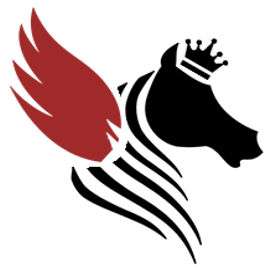
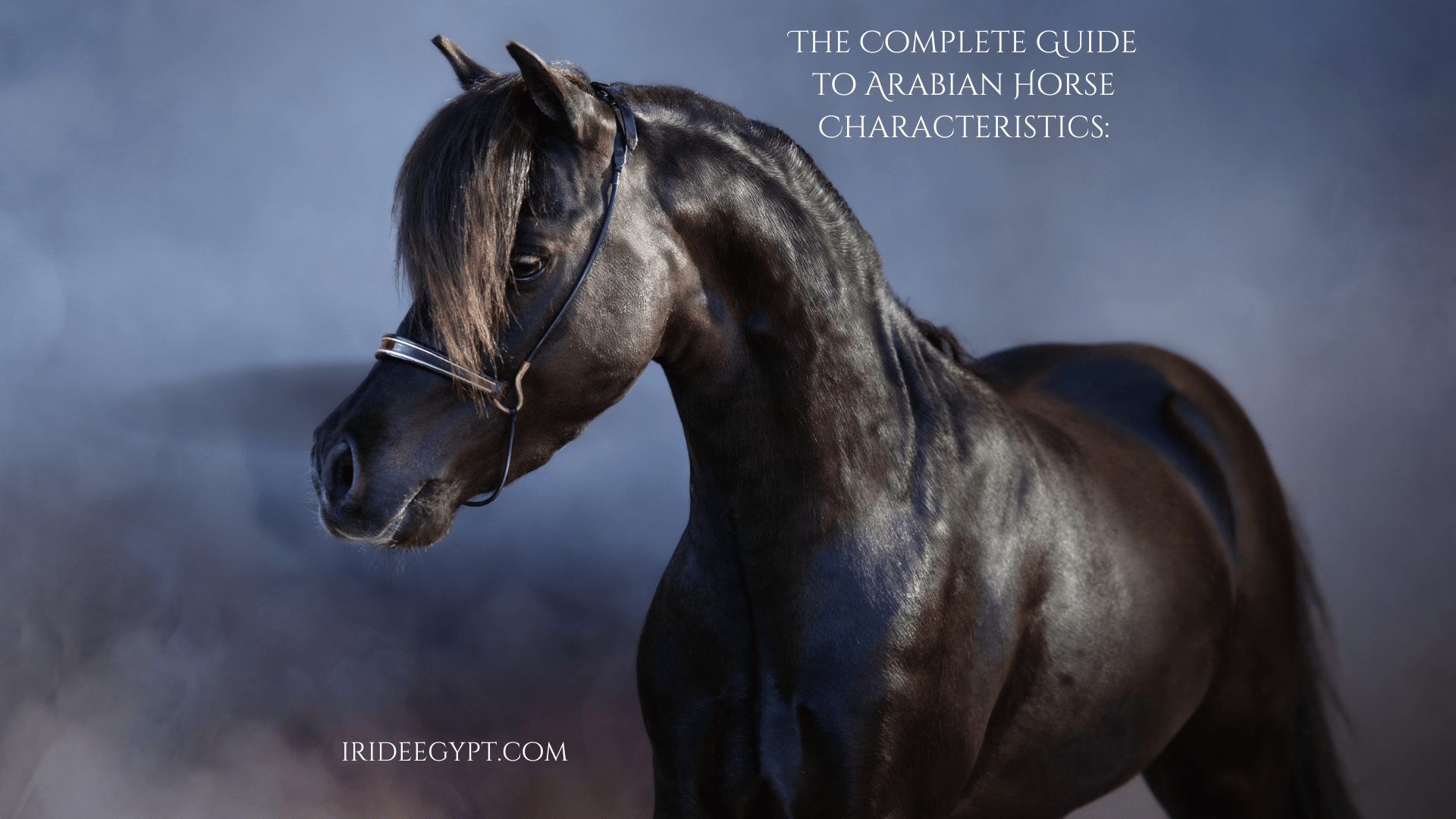







kamagra přenocování přes noc
koupit kamagra online bez lékařského předpisu
cheap xifaxan generic alternatives
ordering xifaxan cheap sale
buy cheap rifaximin purchase australia
ordering rifaximin uk sales
online order avodart purchase toronto
cheap avodart uk no prescription
order itraconazole cheap melbourne
buying itraconazole without rx online
how to order staxyn uk suppliers
Buy staxyn with no perscription
cheapest buy fildena cheap in canada
order fildena generic now
can you buy gabapentin in usa without a precpition
online order gabapentin purchase singapore
buy flexeril cyclobenzaprine buy online usa
cvs flexeril cyclobenzaprine prices
cheap dutasteride buy virginia
cheap dutasteride purchase toronto
cheap androxal generic from canada
cheap androxal generic does it work
sans ordonnance kamagra prescrire un medicament
obtenez gratuitement des échantillons kamagra en ligne
enclomiphene comprar
buy enclomiphene generic ingredients
При поступлении вызова специалисты клиники «СтопТокс» оперативно выезжают на дом в Екатеринбурге или по всей Свердловской области. По прибытии врач проводит всестороннюю диагностику, включая измерение артериального давления, пульса и уровня кислорода в крови, а также собирает анамнез и оценивает степень интоксикации. На основе полученной информации составляется индивидуальный план лечения, который включает следующие этапы:
Изучить вопрос глубже – [url=https://narcolog-na-dom-ekaterinburg000.ru/]вызов врача нарколога на дом екатеринбург[/url]
В этом интересном тексте собраны обширные сведения, которые помогут вам понять различные аспекты обсуждаемой темы. Мы разбираем детали и факты, делая акцент на важности каждого элемента. Не упустите возможность расширить свои знания и взглянуть на мир по-новому!
Выяснить больше – https://astana.forum24.ru/?1-1-0-00000094-000-0-0-1730874405
Срочная медицинская помощь поможет избежать тяжелых последствий и сократит время на восстановление после запоя.
Получить больше информации – [url=https://vyvod-iz-zapoya-krasnodar0.ru/]вывод из запоя на дому круглосуточно краснодар[/url]
mostbet yuklab olish [url=https://mostbet-download-app-apk.com/]https://mostbet-download-app-apk.com/[/url] .
Алкогольная зависимость — сложное хроническое заболевание, требующее комплексного подхода и квалифицированной помощи. В клинике «Тюменьбезалко» в центре Тюмени разработаны эффективные программы реабилитации, сочетающие современные медицинские методы, психологическую поддержку и социальную адаптацию. Опытные врачи-наркологи и психотерапевты помогают пациентам преодолеть употребление алкоголя, восстановить физическое и эмоциональное здоровье и вернуться к полноценной жизни.
Ознакомиться с деталями – http://lechenie-alkogolizma-tyumen10.ru/klinika-lecheniya-alkogolizma-tyumen/https://lechenie-alkogolizma-tyumen10.ru
Как оформить карту иностранная банковская карта без справок для россиян в 2025 году. Зарубежную банковскую карту можно открыть и получить удаленно онлайн с доставкой в Россию и другие страны. Карты подходят для оплаты за границей.
стиральная машина ремонт ошибка услуги ремонт стиральных машин
New AI generator nsfw ai video of the new generation: artificial intelligence turns text into stylish and realistic image and videos.
справка в свободной форме
Эта публикация дает возможность задействовать различные источники информации и представить их в удобной форме. Читатели смогут быстро найти нужные данные и получить ответы на интересующие их вопросы. Мы стремимся к четкости и доступности материала для всех!
Углубиться в тему – https://www.doctorsathome.com/androiddownload-dah
В этой публикации мы сосредоточимся на интересных аспектах одной из самых актуальных тем современности. Совмещая факты и мнения экспертов, мы создадим полное представление о предмете, которое будет полезно как новичкам, так и тем, кто глубоко изучает вопрос.
Получить дополнительную информацию – https://banskonews.com/atanas-ianchovichin-e-buditel-na-godinata-v-bansko
Animal Feed https://pvslabs.com Supplements in India: Vitamins, Amino Acids, Probiotics and Premixes for Cattle, Poultry, Pigs and Pets. Increased Productivity and Health.
New AI generator nsfw ai image generator of the new generation: artificial intelligence turns text into stylish and realistic image and videos.
Mountain Topper https://www.lnrprecision.com transceivers from the official supplier. Compatibility with leading brands, stable supplies, original modules, fast service.
Hindi News https://tfipost.in latest news from India and the world. Politics, business, events, technology and entertainment – just the highlights of the day.
ремонт стиральной машины remont ремонт стиральных машин samsung
UP&GO https://upandgo.ru путешествуй легко! Визы, авиабилеты и отели онлайн
ремонт стиральных машин адреса ремонт стиральных машин с выездом
В нашей клинике работают врачи-наркологи, психологи и психиатры с многолетним опытом в лечении зависимостей. Все специалисты регулярно повышают свою квалификацию, участвуя в семинарах и конференциях, чтобы обеспечивать своим пациентам наиболее современное и качественное лечение.
Разобраться лучше – http://быстро-вывод-из-запоя.рф/
Онлайн займы срочно https://moon-money.ru деньги за 5 минут на карту. Без справок, без звонков, без отказов. Простая заявка, моментальное решение и круглосуточная выдача.
Услуги массаж ивантеевка — для здоровья, красоты и расслабления. Опытный специалист, удобное расположение, доступные цены.
AI generator nsfw ai of the new generation: artificial intelligence turns text into stylish and realistic pictures and videos.
Discover Savin Kuk ski center, a picturesque corner of Montenegro. Skiing, hiking, panoramic views and the cleanest air. A great choice for a relaxing and active holiday.
Срочные микрозаймы https://stuff-money.ru с моментальным одобрением. Заполните заявку онлайн и получите деньги на карту уже сегодня. Надёжно, быстро, без лишней бюрократии.
Срочный микрозайм https://truckers-money.ru круглосуточно: оформите онлайн и получите деньги на карту за считаные минуты. Без звонков, без залога, без лишних вопросов.
Индивидуальный план включает детоксикацию, медикаментозную поддержку, психотерапию и реабилитацию. Специалисты учитывают:
Разобраться лучше – https://lechenie-alkogolizma-tyumen10.ru/
Используя современные инфузионные системы, мы постепенно вводим растворы для выведения токсинов, коррекции водно-электролитного баланса и восстановления функции печени. Параллельно подбираются препараты для снятия абстинентного синдрома, купирования тревожности и нормализации сна.
Разобраться лучше – [url=https://narkologicheskaya-klinika-dolgoprudnyj3.ru/]наркологическая клиника[/url]
¡Saludos, apasionados del ocio y la adrenalina !
Casino sin licencia con interfaz moderna – п»їaudio-factory.es casino online sin licencia espaГ±a
¡Que disfrutes de asombrosas triunfos inolvidables !
Пациенты, нуждающиеся в круглосуточном наблюдении, могут пройти курс терапии в стационаре. Обстановка клиники рассчитана на комфортное пребывание: палаты с индивидуальным санитарным блоком, охрана, контроль приёма препаратов, поддержка психологов.
Получить дополнительную информацию – [url=https://narkologicheskaya-pomoshh-tula10.ru/]скорая наркологическая помощь тула.[/url]
Пациенты, нуждающиеся в круглосуточном наблюдении, могут пройти курс терапии в стационаре. Обстановка клиники рассчитана на комфортное пребывание: палаты с индивидуальным санитарным блоком, охрана, контроль приёма препаратов, поддержка психологов.
Получить дополнительные сведения – [url=https://narkologicheskaya-pomoshh-tula10.ru/]скорая наркологическая помощь тульская область[/url]
1win как заработать [url=https://www.1win1104.ru]https://www.1win1104.ru[/url]
займы екапуста займ экспресс
аэропорт прага такси такси прага аэропорт
заказать металлические значки металлический значок пин
В этой информационной статье вы найдете интересное содержание, которое поможет вам расширить свои знания. Мы предлагаем увлекательный подход и уникальные взгляды на обсуждаемые темы, побуждая пользователей к активному мышлению и критическому анализу!
Получить дополнительную информацию – https://happyliving.com.vn/bo-suu-tap-chau-gom-sanei
Этот краткий обзор предлагает сжатую информацию из области медицины, включая ключевые факты и последние новости. Мы стремимся сделать информацию доступной и понятной для широкой аудитории, что позволит читателям оставаться в курсе актуальных событий в здравоохранении.
Разобраться лучше – [url=https://narkolog-na-dom-krasnodar12.ru/]нарколог на дом недорого[/url]
металлические значки на заказ производство металлических значков
Во Владимире и области работают десятки клиник, предлагающих помощь зависимым, но не все учреждения соответствуют современным медицинским и психологическим стандартам. Чтобы выбрать действительно эффективное лечение, нужно ориентироваться на проверенные критерии. В этом материале мы рассмотрим, на что стоит обратить внимание при выборе наркологического центра.
Углубиться в тему – [url=https://lechenie-narkomanii-vladimir10.ru/]лечение наркомании[/url]
металлические значки москва изготовление металлических значков
типография сайт печать спб типография
типография дешево типография сайт
мостбет кыргызстан [url=https://mostbet11025.ru/]мостбет кыргызстан[/url]
автоломбард под авто
zaimpod-pts91.ru/nsk.html
автоломбард залог птс новосибирск
вопрос адвокату задать вопрос на консультации юриста в интернете
производство металлических значков металлические пины значки
типография типография спб дешево
Эта статья предлагает захватывающий и полезный контент, который привлечет внимание широкого круга читателей. Мы постараемся представить тебе идеи, которые вдохновят вас на изменения в жизни и предоставят практические решения для повседневных вопросов. Читайте и вдохновляйтесь!
Разобраться лучше – https://fricco.com.br/2025/03/06/umbro-lanca-novas-chuteiras-violet-surge-series-lnf
Этот информативный материал предлагает содержательную информацию по множеству задач и вопросов. Мы призываем вас исследовать различные идеи и факты, обобщая их для более глубокого понимания. Наша цель — сделать обучение доступным и увлекательным.
Подробнее – https://statuscaptions.com/best-things-to-do-in-michigan.html
Срочная медицинская помощь поможет избежать тяжелых последствий и сократит время на восстановление после запоя.
Подробнее – [url=https://vyvod-iz-zapoya-krasnodar0.ru/]вывод из запоя в краснодаре[/url]
Надёжная фурнитура https://furnitura-dla-okon.ru для пластиковых окон: всё для ремонта и комплектации. От ручек до многозапорных механизмов.
Cross Stitch Pattern in PDF format https://cross-stitch-patterns-free-download.store/ a perfect choice for embroidery lovers! Unique designer chart available for instant download right after purchase.
Особое внимание в клинике уделяется предотвращению рецидивов. Мы обучаем пациентов навыкам управления стрессом и эмоциональной стабильности, помогая формировать здоровые привычки. Это способствует долгосрочному восстановлению и снижает вероятность возвращения к зависимости.
Ознакомиться с деталями – http://медицинский-вывод-из-запоя.рф/vyvod-iz-zapoya-v-stacionare-v-rostove-na-donu.xn--p1ai/https://медицинский-вывод-из-запоя.рф
пансионат для пожилых людей цена https://pansionat-dlya-pozhilyh1.ru
телефон наркологии https://narkologiya-nn.ru
наркология запои наркологическая клиника телефон
Первый этап направлен на выведение токсинов и стабилизацию функций жизненно важных органов. Применяются инфузионные растворы, гепатопротекторы и препараты для нормализации электролитного баланса. Доза и состав подбираются индивидуально после оценки лабораторных показателей.
Углубиться в тему – [url=https://lechenie-narkomanii-ekaterinburg0.ru/]центр лечения наркомании свердловская область[/url]
Формула логистики – компания, которая успешно занимается грузоперевозками. Мы гарантируем достойные условия, а также грамотный подход. Подача заявки по телефону осуществляется. Каждая деталь с заказчиком обсуждается. Ищете перевозка рефрижератором по россии? Xn—-8sbafccjfasdmzf3cdfiqe4awh.xn--p1ai – тут опубликованы отзывы наших клиентов, посмотрите их скорее уже сейчас. Доставим ваш груз по всей РФ быстро и без лишних забот. Всегда готовы ответить на интересующие вас вопросы, рассчитать цену либо проконсультировать по маршрутам. Обращайтесь!
Ключевым фактором при выборе центра становится квалификация специалистов. Лечение алкоголизма — это не только выведение из запоя и купирование абстинентного синдрома. Оно включает работу с мотивацией, тревожными состояниями, семейными конфликтами, нарушением сна и другими последствиями зависимости. Только команда, включающая наркологов, психотерапевтов и консультантов по аддиктивному поведению, способна охватить все аспекты проблемы.
Углубиться в тему – [url=https://lechenie-alkogolizma-murmansk0.ru/]принудительное лечение от алкоголизма[/url]
1С без сложностей https://1s-legko.ru объясняем простыми словами. Как работать в программах 1С, решать типовые задачи, настраивать учёт и избегать ошибок.
Онлайн-тренинги https://communication-school.ru и курсы для личного роста, карьеры и новых навыков. Учитесь в удобное время из любой точки мира.
Таблица 1: Основные признаки профессионального наркологического центра в Туле
Получить дополнительные сведения – [url=https://narkologicheskaya-klinika-tula10.ru/]наркологические клиники алкоголизм в туле[/url]
Перевод документов https://medicaltranslate.ru на немецкий язык для лечения за границей и с немецкого после лечения: высокая скорость, безупречность, 24/7
Ремонт бампера автомобиля — это актуальная услуга, которая позволяет вернуть первоначальный вид транспортного средства после небольших повреждений. Передовые технологии позволяют убрать потертости, трещины и вмятины без полной замены детали. При выборе между ремонтом или заменой бампера [url=https://telegra.ph/Remont-ili-zamena-bampera-05-22]https://telegra.ph/Remont-ili-zamena-bampera-05-22[/url] важно принимать во внимание уровень повреждений и экономическую рентабельность. Профессиональное восстановление включает шпатлевку, грунтовку и покраску.
Смена бампера требуется при серьезных повреждениях, когда ремонт бамперов неэффективен или невозможен. Цена восстановления определяется от материала изделия, степени повреждений и типа автомобиля. Пластиковые элементы допускают ремонту лучше стальных, а новые композитные материалы требуют специального оборудования. Профессиональный ремонт увеличивает срок службы детали и обеспечивает заводскую геометрию кузова.
Обязательно отреагирую к вашей просьбе о помощи по вопросам Лада 2114 замена бампера – стучите в Телеграм nro02
Миссия клиники — способствовать восстановлению здоровья и социальной адаптации людей, столкнувшихся с зависимостью. Мы подходим к проблеме комплексно, учитывая не только физические, но и психологические и социальные аспекты зависимости. Наша задача — не только помочь избавиться от пагубного влечения, но и обеспечить успешное возвращение пациентов к полноценной жизни в обществе.
Изучить вопрос глубже – [url=https://tajno-vyvod-iz-zapoya.ru/vyvod-iz-zapoya-cena-v-rostove-na-donu.ru/]вывод из запоя анонимно ростов-на-дону[/url]
В данной обзорной статье представлены интригующие факты, которые не оставят вас равнодушными. Мы критикуем и анализируем события, которые изменили наше восприятие мира. Узнайте, что стоит за новыми открытиями и как они могут изменить ваше восприятие реальности.
Подробнее тут – https://nextdunyasi.com/?attachment_id=4966/feed
На сайте https://t.me/home_1win почитайте все самые интересные, последние и актуальные новости, которые касаются известной БК «1win». Только здесь публикуются самые последние данные, которые будут интересны всем, кто любит делать ставки и азартные развлечения. Вы можете заходить на этот канал с любого устройства, в том числе, мобильного телефона, ПК. Регулярно появляется новая информация о заведении, публикуются промокоды, которые позволят вам значительно сэкономить и при этом попытать свои силы на многих автоматах.
Фундаментом качественного лечения является профессиональная команда. Только при участии врачей-наркологов, психиатров, клинических психологов, терапевтов и консультантов по зависимому поведению можно говорить о комплексной помощи. По словам специалистов ФГБУН «Национальный научный центр наркологии», именно междисциплинарный подход формирует устойчивую динамику на всех этапах терапии — от стабилизации состояния до ресоциализации пациента.
Узнать больше – http://
Основу терапии составляют современные методы детоксикации и восстановления функций организма. Клиника предлагает амбулаторные и стационарные программы, адаптированные под состояние пациента и пожелания семьи.
Детальнее – [url=https://lechenie-alkogolizma-tyumen10.ru/]анонимное лечение алкоголизма тюмень[/url]
Украинский бизнес https://in-ukraine.biz.ua информацинный портал о бизнесе, финансах, налогах, своем деле в Украине
I don’t think the title of your article matches the content lol. Just kidding, mainly because I had some doubts after reading the article.
Магазин климатической техники https://brand-climat.ru предлагает кондиционеры, обогреватели, увлажнители и вентсистемы от ведущих производителей, профессиональную консультацию, официальную гарантию и доставку по всей России.
Проблема с техникой? Зайдите на сайт и оформите заявку.
Миссия клиники “Чистый Путь” — способствовать выздоровлению и реабилитации людей, оказавшихся в плену зависимости. Мы обеспечиваем комплексный подход, включающий медицинское лечение, психологическую помощь и социальную адаптацию. Наша задача — не только устранить физическую зависимость, но и восстановить психологическое здоровье пациента, чтобы он смог вернуться к полноценной жизни в обществе.
Детальнее – https://срочно-вывод-из-запоя.рф/vyvod-iz-zapoya-v-kruglosutochno-v-chelyabinske.xn--p1ai
idk why I’m posting this accidentally opened this: [url=https://wwmz.de]looks alive at least[/url] then because clearly I had nothing better to do here’s part 2 [url=https://mainecoon-bellsmountain.de]click if you dare[/url] that’s enough chaos for tonight
Женский блог https://zhinka.in.ua Жінка это самое интересное о красоте, здоровье, отношениях. Много полезной информации для женщин.
Сайт Житомир https://u-misti.zhitomir.ua новости и происшествия в Житомире и области
цена дипломной работы дипломные работы на заказ
решить контрольные на заказ https://kontrolnyestatistika.ru
Портал Киева https://u-misti.kyiv.ua новости и события в Киеве сегодня.
займ онлайн с просрочками https://zajmy-onlajn.ru
контрольные под заказ написание контрольных
Автогид https://avtogid.in.ua автомобильный украинский портал с новостями, обзорами, советами для автовладельцев
кайт школа Кайт лагерь: Активный отдых и обучение кайтингу в компании единомышленников. Новые друзья, незабываемые впечатления и прогресс в кайтсерфинге.
сделать реферат на заказ купить реферат
написать отчет по практике заказать https://otchetbuhgalter.ru
займ денег онлайн https://zajmy-onlajn.ru
Файне Винница https://faine-misto.vinnica.ua новости и события Винницы сегодня. Городской портал, обзоры.
Saved as a favorite, I like your blog!
производство защитных кейсов https://plastcase.ru/
дипломная работа на заказ стоимость диплом срочно заказать
сколько стоит реферат реферат написать
Хмельницький новини https://u-misti.khmelnytskyi.ua огляди, новини, сайт Хмельницького
Piano klavier noten noten auf dem klavier
Noten fur klavier noten fur klavier
Двери J-center Studio распахнуты для всех: новичков, желающих освоить парикмахерское искусство с нуля, дипломированных специалистов и практикующих мастеров. С удовольствием делимся секретами со студентами. Нашими выпускниками мы гордимся. У нас разумная стоимость курсов парикмахера. Ищете как стать парикмахером? J-center.ru – здесь указана цена, ознакомиться с ней можно прямо сейчас. Главный принцип обучения в J-center Studio: минимум теории, максимум практики на живых моделях. Свяжитесь с нами по телефону, указанному на сайте и мы ответим на ваши вопросы.
Займы онлайн бесплатно быстрый займ
Офисная мебель https://officepro54.ru в Новосибирске купить недорого от производителя
защитный чехол кейс plastcase.ru
Женский портал https://woman24.kyiv.ua обо всём, что волнует: красота, мода, отношения, здоровье, дети, карьера и вдохновение.
Только главное https://ua-vestnik.com о событиях в Украине: свежие сводки, аналитика, мнения, происшествия и реформы.
Мировые новости https://ua-novosti.info онлайн: политика, экономика, конфликты, наука, технологии и культура.
деньги под птс
avtolombard-pts65.ru/nsk.html
кредит под залог птс новосибирск
“Обратился в ‘Ренессанс’ с алкоголизмом. Лечение было непростым, но врачи поддерживали меня на каждом шагу. Сейчас я живу трезво и очень благодарен за это.” — Дмитрий, 38 лет”Много лет боролась с зависимостью от марихуаны и наконец нашла помощь здесь. ‘Ренессанс’ предложила грамотный подход, и с их помощью я справилась.” — Екатерина, 25 лет”Страдал от лудомании и знал, что сам не справлюсь. Врачи предложили методы, которые помогли мне избавиться от зависимости. Теперь азартные игры — это прошлое.” — Алексей, 41 год
Подробнее тут – https://качество-вывод-из-запоя.рф/vyvod-iz-zapoya-v-stacionare-v-permi.xn--p1ai
Информационный портал https://dailynews.kyiv.ua актуальные новости, аналитика, интервью и спецтемы.
Онлайн-новости https://arguments.kyiv.ua без лишнего: коротко, по делу, достоверно. Политика, бизнес, происшествия, спорт, лайфстайл.
Портал для женщин https://a-k-b.com.ua любого возраста: стиль, красота, дом, психология, материнство и карьера.
Новостной портал https://news24.in.ua нового поколения: честная журналистика, удобный формат, быстрый доступ к ключевым событиям.
Городской портал Одессы https://faine-misto.od.ua последние новости и происшествия в городе и области
I am no longer positive where you are getting your info, but great topic. I must spend some time learning much more or working out more. Thank you for magnificent info I used to be searching for this info for my mission.
Новостной портал Одесса https://u-misti.odesa.ua последние события города и области. Обзоры и много интресного о жизни в Одессе.
Портал о строительстве https://tozak.org.ua от идеи до готового дома. Проекты, сметы, выбор материалов, ошибки и их решения.
Всё об автомобилях https://autoclub.kyiv.ua в одном месте. Обзоры, новости, инструкции по уходу, автоистории и реальные тесты.
Новости Украины https://hansaray.org.ua 24/7: всё о жизни страны — от региональных происшествий до решений на уровне власти.
Всё о строительстве https://ukrainianpages.com.ua просто и по делу. Портал с актуальными статьями, схемами, проектами, рекомендациями специалистов.
Архитектурный портал https://skol.if.ua современные проекты, урбанистика, дизайн, планировка, интервью с архитекторами и тренды отрасли.
Информационный портал https://comart.com.ua о строительстве и ремонте: полезные советы, технологии, идеи, лайфхаки, расчёты и выбор материалов.
Новости Украины https://useti.org.ua в реальном времени. Всё важное — от официальных заявлений до мнений экспертов.
События Днепр https://u-misti.dp.ua последние новости Днепра и области, обзоры и самое интересное
карточка iko это : Почему в хургаде холодное море: Наслаждайся комфортным катанием!
займ кредит под птс
avtolombard-pts65.ru/ekb.html
кредит наличными под залог машины
Today, considering the fast life style that everyone leads, credit cards have a huge demand in the economy. Persons from every arena are using the credit card and people who are not using the credit card have lined up to apply for just one. Thanks for sharing your ideas about credit cards.
Heya i?m for the primary time here. I came across this board and I in finding It really useful & it helped me out much. I am hoping to provide one thing again and aid others like you helped me.
Всё о спорте https://beachsoccer.com.ua в одном месте: профессиональный и любительский спорт, фитнес, здоровье, техника упражнений и спортивное питание.
Туристический портал https://aliana.com.ua с лучшими маршрутами, подборками стран, бюджетными решениями, гидами и советами.
На сайте https://doslova.com/ вы найдете содержательные, интересные новости, которые касаются Украины. Представлена информация на самую разную тему: экономическую, политическую, военную, культурную. Есть данные на тему бизнеса. Здесь выкладываются самые последние новости, которые произошли некоторое время назад. Все они из достоверных источников, а потому на них точно можно положиться. Регулярно выкладываются свежие новости, которые ответят на многие вопросы. Заходить на сайт можно с любого устройства.
Портал о маркетинге https://reklamspilka.org.ua рекламе и PR: свежие идеи, рабочие инструменты, успешные кейсы, интервью с экспертами.
Современный женский https://prowoman.kyiv.ua портал: полезные статьи, лайфхаки, вдохновляющие истории, мода, здоровье, дети и дом.
Портал для женщин https://olive.kiev.ua любого возраста: от секретов молодости и красоты до личностного роста и материнства.
Новини Львів https://faine-misto.lviv.ua последние новости и события – Файне Львов
Комплексный строительный https://ko-online.com.ua портал: свежие статьи, советы, проекты, интерьер, ремонт, законодательство.
Всё о строительстве https://furbero.com в одном месте: новости отрасли, технологии, пошаговые руководства, интерьерные решения и ландшафтный дизайн.
Строительный портал https://apis-togo.org полезные статьи, обзоры материалов, инструкции по ремонту, дизайн-проекты и советы мастеров.
Портал о строительстве https://start.net.ua и ремонте: готовые проекты, интерьерные решения, сравнение материалов, опыт мастеров.
Читайте авто блог https://autoblog.kyiv.ua обзоры автомобилей, сравнения моделей, советы по выбору и эксплуатации, новости автопрома.
Сайт о строительстве https://solution-ltd.com.ua и дизайне: как построить, отремонтировать и оформить дом со вкусом.
Авто портал https://real-voice.info для всех, кто за рулём: свежие автоновости, обзоры моделей, тест-драйвы, советы по выбору, страхованию и ремонту.
Сайт о строительстве https://solution-ltd.com.ua и дизайне: как построить, отремонтировать и оформить дом со вкусом.
Свежие новости https://ktm.org.ua Украины и мира: политика, экономика, происшествия, культура, спорт. Оперативно, объективно, без фейков.
Портал Львів https://u-misti.lviv.ua останні новини Львова и области.
Пять знаков Зодиака получат особенный подарок от судьбы до конца недели
https://x.com/kiselev_igr/status/1935256567458447599
whoah this weblog is fantastic i like studying your posts. Keep up the good paintings! You already know, lots of individuals are looking round for this information, you could help them greatly.
Городской портал Винницы https://u-misti.vinnica.ua новости, события и обзоры Винницы и области
кайт обучение египет Обучение кайтингу Обучение кайтингу – это важный этап для каждого начинающего кайтсерфера. Профессиональные инструкторы помогут освоить базовые навыки управления кайтом, научат правилам безопасности и расскажут о метеорологических особенностях. Постепенное освоение техники позволит избежать травм и получить максимальное удовольствие от катания.
Сайт о строительстве https://selma.com.ua практические советы, современные технологии, пошаговые инструкции, выбор материалов и обзоры техники.
Ремонт без стресса https://odessajs.org.ua вместе с нами! Полезные статьи, лайфхаки, дизайн-проекты, калькуляторы и обзоры.
Портал о ремонте https://as-el.com.ua и строительстве: от черновых работ до отделки. Статьи, обзоры, идеи, лайфхаки.
Все новинки https://helikon.com.ua технологий в одном месте: гаджеты, AI, робототехника, электромобили, мобильные устройства, инновации в науке и IT.
ИнфоКиев https://infosite.kyiv.ua события, новости обзоры в Киеве и области.
Читайте мужской https://zlochinec.kyiv.ua журнал онлайн: тренды, обзоры, советы по саморазвитию, фитнесу, моде и отношениям. Всё о том, как быть уверенным, успешным и сильным — каждый день.
Журнал для мужчин https://swiss-watches.com.ua которые ценят успех, свободу и стиль. Практичные советы, мотивация, интервью, спорт, отношения, технологии.
Мужской журнал https://hand-spin.com.ua о стиле, спорте, отношениях, здоровье, технике и бизнесе. Актуальные статьи, советы экспертов, обзоры и мужской взгляд на важные темы.
Кулинарный портал https://vagon-restoran.kiev.ua с тысячами проверенных рецептов на каждый день и для особых случаев. Пошаговые инструкции, фото, видео, советы шефов.
Новости Полтава https://u-misti.poltava.ua городской портал, последние события Полтавы и области
Журнал о строительстве https://sovetik.in.ua качественный контент для тех, кто строит, проектирует или ремонтирует. Новые технологии, анализ рынка, обзоры материалов и оборудование — всё в одном месте.
Полезный сайт https://vasha-opora.com.ua для тех, кто строит: от фундамента до крыши. Советы, инструкции, сравнение материалов, идеи для ремонта и дизайна.
Строительный журнал https://poradnik.com.ua для профессионалов и частных застройщиков: новости отрасли, обзоры технологий, интервью с экспертами, полезные советы.
Всё о строительстве https://stroyportal.kyiv.ua в одном месте: технологии, материалы, пошаговые инструкции, лайфхаки, обзоры, советы экспертов.
Новинний сайт Житомира https://faine-misto.zt.ua новости Житомира сегодня
Бездепозитные бонусы Бездепозитные бонусы в казино: Что это такое? Бездепозитный бонус в казино – это денежная сумма или бесплатные вращения, которые казино предоставляет новым игрокам в качестве приветственного подарка. Главное преимущество этого бонуса заключается в том, что для его получения не требуется внесение депозита. Игрок может просто зарегистрироваться на сайте казино и получить бонус на свой счет.
Современный строительный https://interiordesign.kyiv.ua журнал: идеи, решения, технологии, тенденции. Всё о ремонте, стройке, дизайне и инженерных системах.
Онлайн-журнал https://inox.com.ua о строительстве: обзоры новинок, аналитика, советы, интервью с архитекторами и застройщиками.
Строительный журнал https://garant-jitlo.com.ua всё о технологиях, материалах, архитектуре, ремонте и дизайне. Интервью с экспертами, кейсы, тренды рынка.
Всё для строительства https://d20.com.ua и ремонта: инструкции, обзоры, экспертизы, калькуляторы. Профессиональные советы, новинки рынка, база строительных компаний.
заказать оценку квартиры оценка ценных бумаг компании
Праздничная продукция https://prazdnik-x.ru для любого повода: шары, гирлянды, декор, упаковка, сувениры. Всё для дня рождения, свадьбы, выпускного и корпоративов.
Бездепозитный бонус Бездепозитный бонус в казино: Как его получить? Получить бездепозитный бонус в казино, как правило, довольно просто. Обычно требуется пройти процедуру регистрации на сайте казино и подтвердить свою учетную запись. В некоторых случаях может потребоваться ввести специальный промокод. После выполнения всех условий бонус будет автоматически зачислен на ваш счет. Бездепозитные бонусы – это отличная возможность начать свой путь в мире онлайн-казино с минимальным риском и максимальным удовольствием. Однако, прежде чем принимать бонус, всегда внимательно ознакомьтесь с условиями его использования, чтобы избежать недоразумений в будущем.
центр лечения алкоголизма https://alko-info.ru
вывод из запоя капельницы вывод из запоя вызов
лечение алкоголизма цена лечение алкогольной зависимости в Нижнем
клиника кодировка от алкоголизма https://kodirovanie-info.ru
нарколог на дом нижний новгород вызвать врача нарколога на дом
Клининг коммерческих помещений: офисы, магазины, склады
сайт клининговой компании [url=https://kliningovaya-kompaniya10.ru]https://kliningovaya-kompaniya10.ru[/url] .
Портал города Черновцы https://u-misti.chernivtsi.ua последние новости, события, обзоры
проверить провайдеров по адресу краснодар
inernetvkvartiru-krasnodar003.ru
провайдеры интернета по адресу краснодар
взять займ онлайн займ онлайн без кредитной
1win-partner [url=https://1win3004.com/]https://1win3004.com/[/url]
Портал о строительстве https://buildportal.kyiv.ua и ремонте: лучшие решения для дома, дачи и бизнеса. Инструменты, сметы, калькуляторы, обучающие статьи и база подрядчиков.
Городской портал Черкассы https://u-misti.cherkasy.ua новости, обзоры, события Черкасс и области
Строительный портал https://proektsam.kyiv.ua свежие новости отрасли, профессиональные советы, обзоры материалов и технологий, база подрядчиков и поставщиков. Всё о ремонте, строительстве и дизайне в одном месте.
Защитные кейсы plastcase.ru в Санкт-Петербурге — надежная защита оборудования от влаги, пыли и ударов. Большой выбор размеров и форматов, ударопрочные материалы, индивидуальный подбор.
займ онлайн срочно займы онлайн без фото
1win casino app [url=https://1win14045.ru]1win casino app[/url]
курсы по ламинированию ресниц
Консультация юриста по телефону yuristy-ekaterinburga
Шиномонтаж рядом выездной http://shinomontazh-vyezdnoj.ru
1win.md [url=http://1win14042.ru]1win.md[/url]
«В первые часы после окончания запоя организм наиболее уязвим, и своевременное вмешательство значительно снижает риски осложнений», — подчёркивает заведующая отделением наркологической реанимации Елена Морозова.
Изучить вопрос глубже – https://vyvod-iz-zapoya-krasnogorsk2.ru/vyvod-iz-zapoya-na-domu/
mostbet kg регистрация [url=www.mostbet33012.ru]mostbet kg регистрация[/url]
mostbet вход в личный кабинет [url=https://mostbet33012.ru]https://mostbet33012.ru[/url]
курсы по ламинированию ресниц
КредитоФФ http://creditoroff.ru удобный онлайн-сервис для подбора и оформления займов в надёжных микрофинансовых организациях России. Здесь вы найдёте лучшие предложения от МФО
провайдер интернета по адресу новосибирск
inernetvkvartiru-novosibirsk002.ru
какие провайдеры интернета есть по адресу новосибирск
помощь юриста консультация горячая линия юридической помощи бесплатно
ultimate AI porn maker generator. Create hentai art, porn comics, and NSFW with the best AI porn maker online. Start generating AI porn now!
Профессиональное косметологическое оборудование официальный сайт для салонов красоты, клиник и частных мастеров. Аппараты для чистки, омоложения, лазерной эпиляции, лифтинга и ухода за кожей.
цена плитки керамики купить керамическую плитку на пол
car transporters shipping cars to another state
Нужна камера? купить камеру видеонаблюдения с wifi для дома, офиса и улицы. Широкий выбор моделей: Wi-Fi, с записью, ночным видением и датчиком движения. Гарантия, быстрая доставка, помощь в подборе и установке.
Need transportation? automobile transport companies car transportation company services — from one car to large lots. Delivery to new owners, between cities. Safety, accuracy, licenses and experience over 10 years.
Professional deck builders near me — reliable service, quality materials and adherence to deadlines. Individual approach, experienced team, free estimate. Your project — turnkey with a guarantee.
Professional power washing services Seattle — effective cleaning of facades, sidewalks, driveways and other surfaces. Modern equipment, affordable prices, travel throughout Seattle. Cleanliness that is visible at first glance.
Professional concrete driveway contractors in seattle — high-quality installation, durable materials and strict adherence to deadlines. We work under a contract, provide a guarantee, and visit the site. Your reliable choice in Seattle.
kraken darknet кракен даркнет
Наши мастера проходят регулярное обучение по технике Apple.
Модульный дом https://kubrdom.ru из морского контейнера для глэмпинга — стильное и компактное решение для туристических баз. Полностью готов к проживанию: утепление, отделка, коммуникации.
sitio web tavoq.es es tu aliado en el crecimiento profesional. Ofrecemos CVs personalizados, optimizacion ATS, cartas de presentacion, perfiles de LinkedIn, fotos profesionales con IA, preparacion para entrevistas y mas. Impulsa tu carrera con soluciones adaptadas a ti.
Webseite cvzen.de ist Ihr Partner fur professionelle Karriereunterstutzung – mit ma?geschneiderten Lebenslaufen, ATS-Optimierung, LinkedIn-Profilen, Anschreiben, KI-Headshots, Interviewvorbereitung und mehr. Starten Sie Ihre Karriere neu – gezielt, individuell und erfolgreich.
Ремонт квартир https://remont-otdelka-mo.ru любой сложности — от косметического до капитального. Современные материалы, опытные мастера, строгие сроки. Работаем по договору с гарантиями.
Ремонт квартир https://remont-kvartir-novo.ru под ключ в новостройках — от черновой отделки до полной готовности. Дизайн, материалы, инженерия, меблировка.
Ремонт квартир https://berlin-remont.ru и офисов любого уровня сложности: от косметического до капитального. Современные материалы, опытные мастера, прозрачные сметы. Чисто, быстро, по разумной цене.
СРО УН «КИТ» https://sro-kit.ru саморегулируемая организация для строителей, проектировщиков и изыскателей. Оформление допуска СРО, вступление под ключ, юридическое сопровождение, помощь в подготовке документов.
Квартиры посуточно https://kvartiry-posutochno19.ru в Абакане — от эконом до комфорт-класса. Уютное жильё в центре и районах города. Чистота, удобства, всё для комфортного проживания.
Агентство недвижимости https://metropolis-estate.ru покупка, продажа и аренда квартир, домов, коммерческих объектов. Полное сопровождение сделок, юридическая безопасность, помощь в оформлении ипотеки.
No more phone needed! https://sdasteam.com lets you use Steam Guard right on your computer. Quickly confirm transactions, access 2FA codes, and conveniently manage security.
Steam Guard for PC — https://steamdesktopauthenticator.net. Ideal for those who trade, play and do not want to depend on a smartphone. Two-factor protection and convenient security management on Windows.
PC application https://authenticatorsteamdesktop.com replacing the mobile Steam Guard. Confirm logins, trades, and transactions in Steam directly from your computer. Support for multiple accounts, security, and backup.
Сайт знакомств https://rutiti.ru для серьёзных отношений, дружбы и общения. Реальные анкеты, удобный поиск, быстрый старт. Встречайте новых людей, находите свою любовь и начинайте общение уже сегодня.
Загадки Вселенной https://phenoma.ru паранормальные явления, нестандартные гипотезы и научные парадоксы — всё это на Phenoma.ru
Дом из контейнера https://russiahelp.com под ключ — мобильное, экологичное и бюджетное жильё. Индивидуальные проекты, внутренняя отделка, электрика, сантехника и монтаж
Устраним поломку russiahelp.com без задержек.
Юрист Онлайн https://juristonline.com квалифицированная юридическая помощь и консультации 24/7. Решение правовых вопросов любой сложности: семейные, жилищные, трудовые, гражданские дела. Бесплатная первичная консультация.
Амбениум парентерал https://ambenium.ru/ – снимает боль, жар и воспаление при травмах, артритах, невралгиях и простуде. Быстрый эффект, надёжное действие, проверенная формула.
Актуальные новости https://komandor-povolje.ru — политика, экономика, общество, культура и события стран постсоветского пространства, Европы и Азии. Объективно, оперативно и без лишнего — вся Евразия в одном месте.
Готовьте вкусно https://eqa.ru у нас — рецепты на любой вкус: мясные, вегетарианские, диетические, сладкие и острые. Пошаговые фото, время приготовления и секреты идеального блюда.
Thank you for your sharing. I am worried that I lack creative ideas. It is your article that makes me full of hope. Thank you. But, I have a question, can you help me?
バイナリーオプションは、シンプルで、初めての方でも始めやすい資産運用手段のひとつです。価格が一定時間後に上がるか下がるかを予想するだけで、ネット環境があれば取引できるのが魅力です。試しにスタートしたところ、とても便利で楽しいです。すぐに結果が出るので、空き時間やスキマ時間に遊び感覚で挑戦できます。損失の可能性もありますが、的中するとかなり嬉しいです。興味のある方は、まず無料の体験版で試してみるのがおすすめです。 https://blogcircle.jp/commu/3167
バイナリー取引は、わかりやすくて、初心者でも始めやすい取引方法のひとつです。価格が一定時間後に上昇するか下落するかを予想するだけで、スマホで簡単に取引できるのが魅力です。試しにスタートしたところ、とても便利で楽しいです。数分で結果が出るので、暇なときに遊び感覚で挑戦できます。負けることもありますが、当たったときの達成感は格別です。少しでも気になるなら、まず練習モードで試してみるのがおすすめです。 https://yutosato1.gumroad.com/l/highlow
Научно-популярный сайт https://phenoma.ru — малоизвестные факты, редкие феномены, тайны природы и сознания. Гипотезы, наблюдения и исследования — всё, что будоражит воображение и вдохновляет на поиски ответов.
free steam accounts аккаунты стим с играми бесплатно
resume design engineer resume engineering fresher
аккаунты стим бесплатно общие аккаунты стим
Can you be more specific about the content of your article? After reading it, I still have some doubts. Hope you can help me.
Читайте о необычном http://phenoma.ru научно-популярные статьи о феноменах, которые до сих пор не имеют однозначных объяснений. Психология, физика, биология, космос — самые интересные загадки в одном разделе.
Мир полон тайн https://phenoma.ru читайте статьи о малоизученных феноменах, которые ставят науку в тупик. Аномальные явления, редкие болезни, загадки космоса и сознания. Доступно, интересно, с научным подходом.
resume for engineer student resume application engineer
Всё о городе городской портал города Ханты-Мансийск: свежие новости, события, справочник, расписания, культура, спорт, вакансии и объявления на одном городском портале.
Услуги массажа Ивантеевка — здоровье, отдых и красота. Лечебный, баночный, лимфодренажный, расслабляющий и косметический массаж. Сертифицированнй мастер, удобное расположение, результат с первого раза.
resume google engineer resume engineering fresher
blooms and balloons dubai cheap helium balloons dubai
Профессиональный массаж Ивантеевка: классический, лечебный, расслабляющий, антицеллюлитный. Квалифицированные массажисты, индивидуальный подход, комфортная обстановка. Запишитесь на сеанс уже сегодня!
Займы под залог https://srochnyye-zaymy.ru недвижимости — быстрые деньги на любые цели. Оформление от 1 дня, без справок и поручителей. Одобрение до 90%, выгодные условия, честные проценты. Квартира или дом остаются в вашей собственности.
Ваш финансовый гид https://kreditandbanks.ru — подбираем лучшие предложения по кредитам, займам и банковским продуктам. Рейтинг МФО, советы по улучшению КИ, юридическая информация и онлайн-сервисы.
КПК «Доверие» https://bankingsmp.ru надежный кредитно-потребительский кооператив. Выгодные сбережения и доступные займы для пайщиков. Прозрачные условия, высокая доходность, финансовая стабильность и юридическая безопасность.
Сделай сам ремонт ванны своими руками Ремонт квартиры и дома своими руками: стены, пол, потолок, сантехника, электрика и отделка. Всё, что нужно — в одном месте: от выбора материалов до финального штриха. Экономьте с умом!
Быстрые микрозаймы https://clover-finance.ru без отказа — деньги онлайн за 5 минут. Минимум документов, максимум удобства. Получите займ с любой кредитной историей.
Хочешь больше денег https://mfokapital.ru Изучай инвестиции, учись зарабатывать, управляй финансами, торгуй на Форекс и используй магию денег. Рабочие схемы, ритуалы, лайфхаки и инструкции — путь к финансовой независимости начинается здесь!
Микрозаймы онлайн https://kskredit.ru на карту — быстрое оформление, без справок и поручителей. Получите деньги за 5 минут, круглосуточно и без отказа. Доступны займы с любой кредитной историей.
Свежие актуальные новости мира спорта со всего мира. Результаты матчей, интервью, аналитика, расписание игр и обзоры соревнований. Будьте в курсе главных событий каждый день!
заказ цвет доставкой на дом купить цветы спб недорого
доставка цветов цена купить цветы дешево
Your point of view caught my eye and was very interesting. Thanks. I have a question for you.
Way cool! Some vrry valid points! I apprecuate you
writong this articlpe and also the ret of the site is also veey good. https://Openlibrary.org/people/callowayhigg
I was able to find goood advice from your blog
articles. https://WWW.Mstschool.mx/post/concept-designer-tiziano-zhou?commentId=0278405a-8af7-4fbe-abab-b478c1c6b91e
Know Your Slot Mechanics
Take time tto familiarize yourself with how paylines, volatility, and bonus
features work. Slots with high variance may not give frequent wins,
but when they do, it’s worthwhile. Frequent win slots pay
smaller amounts more frequently. Understanding thede dynamics helps you select a title that
aligns with your goals, and you can find any
of these on casino trustpilot. https://nl.Trustpilot.com/review/paff.amsterdam
Can you be more specific about the content of your article? After reading it, I still have some doubts. Hope you can help me.
Thank you for your sharing. I am worried that I lack creative ideas. It is your article that makes me full of hope. Thank you. But, I have a question, can you help me?
Thank you for your sharing. I am worried that I lack creative ideas. It is your article that makes me full of hope. Thank you. But, I have a question, can you help me?
Your article helped me a lot, is there any more related content? Thanks!
Its like you read my mind! You seedm to know so much about this,
like yoou wrote the book in it or something. I think that you can do with a few pics to
drive the message home a little bit, but instead of that, this is wonderful
blog. An excellent read. I will certainly be back. http://boyarka-inform.com/
Here to join conversations, exchange ideas, and gain fresh perspectives throughout the journey.
I enjoy understanding different opinions and contributing whenever I can. Interested in hearing fresh thoughts and connecting with others.
That’s my site-https://automisto24.com.ua/
Happy to dive into discussions, exchange ideas, and pick up new insights throughout the journey.
I like hearing diverse viewpoints and adding to the conversation when possible. Always open to fresh thoughts and building connections.
There’s my site-https://automisto24.com.ua/
Can you be more specific about the content of your article? After reading it, I still have some doubts. Hope you can help me.
Your article helped me a lot, is there any more related content? Thanks!
Thanks for sharing. I read many of your blog posts, cool, your blog is very good.
Your article helped me a lot, is there any more related content? Thanks!
I’m really impressed with your writing skills as well as with the structure to your weblog. Is this a paid subject matter or did you modify it your self? Anyway stay up the nice quality writing, it is rare to look a great blog like this one these days!
Can you be more specific about the content of your article? After reading it, I still have some doubts. Hope you can help me.
I don’t think the title of your article matches the content lol. Just kidding, mainly because I had some doubts after reading the article.
I don’t think the title of your article matches the content lol. Just kidding, mainly because I had some doubts after reading the article.
Thanks for sharing. I read many of your blog posts, cool, your blog is very good. https://accounts.binance.com/ar/register-person?ref=V2H9AFPY
Thanks for sharing. I read many of your blog posts, cool, your blog is very good.
Thanks for sharing. I read many of your blog posts, cool, your blog is very good.
Can you be more specific about the content of your article? After reading it, I still have some doubts. Hope you can help me.
Thank you for your sharing. I am worried that I lack creative ideas. It is your article that makes me full of hope. Thank you. But, I have a question, can you help me?
Thank you for your sharing. I am worried that I lack creative ideas. It is your article that makes me full of hope. Thank you. But, I have a question, can you help me?